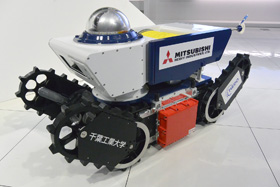Press Information
Joint Development of Japan's First Anti-Explosive Remotely Operated Mobile Robot
Contributing to Safe and Efficient Data Collection and Inspection in Tunnel Accidents and Petrochemical Plants
Contributing to Safe and Efficient Data Collection and Inspection in Tunnel Accidents and Petrochemical Plants
Mitsubishi Heavy Industries, Ltd. (Headquarters: Minato-ku, Tokyo, President and CEO: Shunichi Miyanaga, hereinafter MHI) and Chiba Institute of Technology (Headquarters: Minato-ku, Tokyo, Board Chairman: Osamu Setokuma, hereinafter CIT) have jointly developed the remotely operated "Sakura No. 2 (anti-explosive model)" robot that features greatly reduced risk of electrical spark or heat creation that can cause explosions or fire when inflammable gas is present. It is the first mobile robot in Japan that can be remotely operated either wirelessly or by wire to be officially certified as anti-explosive. Applications and demand will be developed for safe and efficient data collection, inspection and light work in environments that require equipment to be anti-explosive such as tunnel accidents and petrochemical plants.

In order to make the robot anti-explosive, the pressure resistant anti-explosive casing that houses components such as the lithium ion batteries and BMS (battery management system) and the casing for the electrical parts such as the motor and controller have a higher internal pressure than the external atmosphere, giving a two-fold internal pressure plus pressure resistant anti-explosive protection. This means that inflammable gases cannot penetrate to the interior of the casing due to the pressure difference, and if the casing internal pressure drops, for example if the casing is damaged, this is detected and the power supply is cut off. Since the batteries for storing electricity are protected by a pressure resistant anti-explosive casing that was jointly developed by IDEC Corporation (Headquarters: Yodogawa-ku, Osaka, Chairman & CEO: Toshi K. Funaki), the risk of igniting gas due to electrical sparks or heat has been greatly reduced. Due to its advanced anti-explosive design the robot can operate in highly explosive and diffusible hydrogen gas, and can be used in zone 1 hazardous areas *2.
It is hoped that the robot can be used in many situations in addition to applications such as methane gas spouts during excavation and tunnel accidents with a high risk of ignition or explosion due to vehicle fuel leaks. In future, the deterioration of much social infrastructure that was built after the high growth period and industrial infrastructure such as oil refining plants, chemical plants and power plants will accelerate, increasing the risk of damage to people and society. Therefore, needs are growing for robots that can carry out investigations of abnormalities and perform light work for emergency inspections and rapid recovery at the time of disasters, as well as for preventing and limiting disasters. There is also a trend toward using robots in applications such as new oil field facilities or oil and chemical related facilities to carry out work such as inspections at low cost and with high precision in places that are hard for humans to work in such as working at height or in confined areas.
In addition to making efforts to arouse needs from all sides on the occasion of the development of the Sakura No. 2 robot (anti-explosive model), MHI and CIT will strive to further expand applications and reveal potential needs, with initiatives such as developing an anti-explosive robot arm and a self-driving robot.
| External dimensions | L 710 × W 420 × H 540mm (with sub-crawler stored) |
|---|---|
| Main unit weight | 60kg |
| Travel speed | 1.2kph |
| Climbing angle | 45° (climbing and descending possible) |
| Travel / climb method | Joint use of 2 main crawlers and 4 sub crawlers with adjustable angle at the side that can be extended forward or backward. |
| Continuous operation time | 2.5 hours |
| Remote operation communication distance | 100m with wireless operation. 1,000m with wired operation using fiber optic cable reel developed by CIT. |
| Environmental data collection method | Equipped with PTZ camera *3, gas detector |
| Environmental resistance | IP47 (protection against objects with diameter of 1mm or larger and temporary water submersion |
| Anti-explosive specification | Ex px[d] II B+H2 T4 Gb Internal pressure + pressure resistant anti-explosive method, may be used in inflammable gas including hydrogen and zone 1 areas |
*1 The R&D theme "Project to develop systems to handle the social challenges of infrastructure maintenance management and renewal / Infrastructure maintenance management robot technology and non-destructive inspection equipment development / R&D of exploration robots for inflammable gas atmospheres" is a 4-year plan, of which FY2014 to FY2015 was an outsourced project and FY2016 to FY207 is a support project.
*2 Second of three hazardous area classifications: A place in which a hazardous atmosphere is likely to occur in normal operation. Applies to almost all hazardous places other than inside oil tanks (zone 0).
*3 The PTZ camera that can handle Pan (horizontal motion), Tilt (vertical motion), and Zoom (wide to zoom) was successfully incorporated through cooperation with MIYAKI ELECTRIC MFG. Co., Ltd. (Headquarters: Kameoka, Kyoto, President: Koji Kawara).
About MHI Group
Mitsubishi Heavy Industries (MHI) Group is one of the world’s leading industrial groups, spanning energy, smart infrastructure, industrial machinery, aerospace and defense. MHI Group combines cutting-edge technology with deep experience to deliver innovative, integrated solutions that help to realize a carbon neutral world, improve the quality of life and ensure a safer world. For more information, please visit www.mhi.com or follow our insights and stories on spectra.mhi.com.






